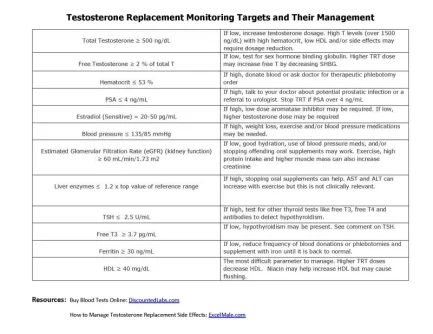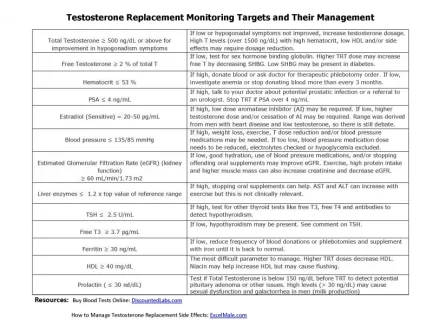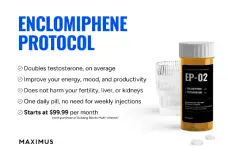You are using an out of date browser. It may not display this or other websites correctly.
You should upgrade or use an alternative browser.
You should upgrade or use an alternative browser.
Requesting Input: TRT Targets and Monitoring Table
- Thread starter Nelson Vergel
- Start date
CoastWatcher
Moderator
On the PSA line: I would add language that the patient should "discuss suspending TRT with physician if psa is over 4ng/ml." Termination, which you suggest isn't always necessary (but a full work-up is).
On the estradiol line: I would add language that elevated estradiol "may be dealt with by adjusting dosage frequency and the amount of testosterone administered" along with what you have about an AI.
On liver enzymes: I think it's unclear as to what you're referring to when you write about exercise being "not clinically relevant." Perhaps a small expansion?
On the estradiol line: I would add language that elevated estradiol "may be dealt with by adjusting dosage frequency and the amount of testosterone administered" along with what you have about an AI.
On liver enzymes: I think it's unclear as to what you're referring to when you write about exercise being "not clinically relevant." Perhaps a small expansion?
Nelson Vergel
Founder, ExcelMale.com
Vince Carter
Banned
I would draw attention to the PSA values at less than 4, I wouldn't want some one ignoring it, til it hits a 4 and then reacting. Maybe something of a 2 or refer to tests that are trending upward but I'd want to take action well before it hit a 4.
Estrogen....I also think referring to a 50 as a high limit might be too high.
Estrogen....I also think referring to a 50 as a high limit might be too high.
CoastWatcher
Moderator
I would draw attention to the PSA values at less than 4, I wouldn't want some one ignoring it, til it hits a 4 and then reacting. Maybe something of a 2 or refer to tests that are trending upward but I'd want to take action well before it hit a 4.
Estrogen....I also think referring to a 50 as a high limit might be too high.
I tend to agree w/Vince Carter in regard to the upper limit for estradiol (50) being too high. I recognize this opens up a door to the entire issue of just where estradiol ought to sit, but I believe, based on my own history and my doctor's discussion, that e2 ought to be seriously evaluated when it hits 40. Intervention may not be necessary, but a hard look is.
Last edited:
Fireproof
Member
I tend to agree w/Vince Carter in regard to the upper limit for estradiol (50) being too high. I recognize this opens up a door to the entire issue of just where estradiol ought to sit, but I believe, based on my own history and my doctor's discussion, that e2 ought to be seriously evaluated when it hits 40. Intervention may not be necessary, but a hard look is.
Yep - based on my experience - 20-40 seems a more reasonable range, and consistent with discussions with my docs. And like CoastWatcher said - just because you are at 46 or 50 doesn't necessarily mean you have to address it - but it should be looked at closely...
Nelson, didn't JAMA do a study on Estradiol and Mortality in Older Men and Life Extensions quoted it that ranges of 20-30 pg/ml (regular estradiol - not sensitive) were the healthiest ranges for prevention of cardiovascular deaths? Then we can assume the E2 range would be lower than 20-30... Just thinking out loud and would appreciate any comments. I would rather have guidelines based on actual controlled studies if possible.
Also, from what I have read from other post here, some are more sensitive to higher ranges of E2 like over 30, possibly due to the effect of SHBG levels.
Also, from what I have read from other post here, some are more sensitive to higher ranges of E2 like over 30, possibly due to the effect of SHBG levels.
Nelson Vergel
Founder, ExcelMale.com
Nelson, didn't JAMA do a study on Estradiol and Mortality in Older Men and Life Extensions quoted it that ranges of 20-30 pg/ml (regular estradiol - not sensitive) were the healthiest ranges for prevention of cardiovascular deaths? Then we can assume the E2 range would be lower than 20-30... Just thinking out loud and would appreciate any comments. I would rather have guidelines based on actual controlled studies if possible.
Also, from what I have read from other post here, some are more sensitive to higher ranges of E2 like over 30, possibly due to the effect of SHBG levels.
I am glad someone is reading studies!
Yes, this one. But men had an average of 320 ng/dL of total testosterone blood levels and pre-existing heart disease.
Until someone does a study with men with TT > 500 ng/dL and healthy, I won't trust that upper limit. The higher the T, the higher the E2. They balance and enhance each other.
Having said that, the study used the old estradiol testing method which over estimates E2, so the actual upper limit may not be too far from 50 pg/mL.
STUDY LOOKING AT EFFECT OF ESTRADIOL ON MORTALITY IN MEN:
This study found that estradiol levels of < 21.80 pg/ml and > 30.11 pg/ml resulted in greater mortality in men.
Abstract
CONTEXT:
Androgen deficiency is common in men with chronic heart failure (HF) and is associated with increased morbidity and mortality. Estrogens are formed by the aromatization of androgens; therefore, abnormal estrogen metabolism would be anticipated in HF.
OBJECTIVE:
To examine the relationship between serum concentration of estradiol and mortality in men with chronic HF and reduced left ventricular ejection fraction (LVEF).
DESIGN, SETTING, AND PARTICIPANTS:
A prospective observational study at 2 tertiary cardiology centers (Wroclaw and Zabrze, Poland) of 501 men (mean [SD] age, 58 [12] years) with chronic HF, LVEF of 28% (SD, 8%), and New York Heart Association [NYHA] classes 1, 2, 3, and 4 of 52, 231, 181, and 37, respectively, who were recruited between January 1, 2002, and May 31, 2006. Cohort was divided into quintiles of serum estradiol
quintile 1, < 12.90 pg/mL;
quintile 2, 12.90-21.79 pg/mL;
quintile 3, 21.80-30.11 pg/mL;
quintile 4, 30.12-37.39 pg/mL;
and quintile 5, > or = 37.40 pg/mL.
Quintile 3 was considered prospectively as the reference group.
MAIN OUTCOME MEASURES:
Serum concentrations of estradiol and androgens (total testosterone and dehydroepiandrosterone sulfate [DHEA-S]) were measured using immunoassays.
RESULTS:
Among 501 men with chronic HF, 171 deaths (34%) occurred during the 3-year follow-up. Compared with quintile 3, men in the lowest and highest estradiol quintiles had increased mortality (adjusted hazard ratio
, 4.17; 95% confidence interval [CI], 2.33-7.45 and HR, 2.33; 95% CI, 1.30-4.18; respectively; P < .001). These 2 quintiles had different clinical characteristics (quintile 1: increased serum total testosterone, decreased serum DHEA-S, advanced NYHA class, impaired renal function, and decreased total fat tissue mass; and quintile 5: increased serum bilirubin and liver enzymes, and decreased serum sodium; all P < .05 vs quintile 3). For increasing estradiol quintiles, 3-year survival rates adjusted for clinical variables and androgens were 44.6% (95% CI, 24.4%-63.0%), 65.8% (95% CI, 47.3%-79.2%), 82.4% (95% CI, 69.4%-90.2%), 79.0% (95% CI, 65.5%-87.6%), and 63.6% (95% CI, 46.6%-76.5%); respectively (P < .001).
Reference:
Circulating estradiol and mortality in men with systolic chronic heart failure.
JAMA 2009 May 13;301(18):1892-901.
Vettester Chris
Super Moderator
The reference range for Free T3 at Labcorp (and others) is 2.0pg/ml - 4.4pg/ml ... > 3.7pg/ml would put a person at 70% of the reference range with that lab, which "could" too hyper like for a lot of people.
My suggestion is to aim for 50% to 80% of the lab's reference range (start low, titrate up until optimal), which could be applicable for both Free T4 and Free T3. This will cover Labcorp and other lab providers that might use a different interval system and/or unit of measurement.
My suggestion is to aim for 50% to 80% of the lab's reference range (start low, titrate up until optimal), which could be applicable for both Free T4 and Free T3. This will cover Labcorp and other lab providers that might use a different interval system and/or unit of measurement.
hCG Mixing Calculator
HCG Mixing Protocol Calculator
Similar threads
- Replies
- 1
- Views
- 914
- Replies
- 4
- Views
- 5K
- Replies
- 0
- Views
- 575
- Locked
- Replies
- 1
- Views
- 4K
- Locked
- Sticky
- Replies
- 8
- Views
- 78K
Online statistics
- Members online
- 2
- Guests online
- 930
- Total visitors
- 932
Totals may include hidden visitors.
Latest posts
-
-
-
Any Testosterone Propionate Compounding Pharmacies left?
- Latest: Guided_by_Voices
-
-
-
-
-
-
-
















